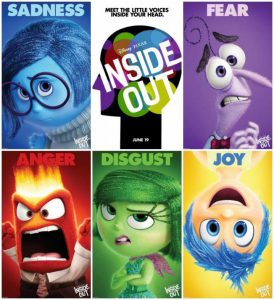The idea that talking about your feelings is a good thing is definitely not new. Folk wisdom dictates “Get it off your chest and you’ll feel better” and research seems to agree. Experimental research in the last few decades has explored the mechanisms of verbalizing affect more closely.
The idea for this blog post came after a long drunken discussion at the pub during my husband’s after-work drinks about gender differences in emotionality (yes, that’s what we talk about at the pub). At some point there was one of those dreaded questions starting with “As a psychologist, what do you think…” asking: “why do we need to talk about our emotions?” (imagine this in a sarcastic tone) “What’s wrong with just controlling them?”. My response that baffled my male audience that night was that talking about emotions IS a way of controlling them.
In one of the first neuroimaging studies to explore the effects of putting feelings into words, Hariri et al. (2000) asked participants to view emotional facial expressions and assign either an emotional (e.g. angry, afraid) or a non-emotional (e.g. assign a male or female name to the face) label. They found that using an emotional label to describe the picture compared to non-emotional ones led to increased activations in inhibitory networks in the pre-frontal cortex and reduced activations in amygdala (an area involved in emotional responses). This pattern of neural activity is typically observed when individuals intentionally try to down-regulate or control their emotions (Ochsner et al., 2004). Thus, the process of putting emotions into words seems to unintentionally activate a process of emotion regulation.
“…the process of putting emotions into words seems to unintentionally activate a process of emotion regulation.”
Since then, various studies have replicated this effect (Lieberman et al., 2007) and illustrated the benefits of affect labelling more clearly. Labelling has been found to reduce the subjective experience of negative emotions (Lieberman et al., 2011), but also the experience of physical symptoms (Constantinou et al., 2014). Furthermore, studies have shown that incorporating affect labelling in exposure therapy can increase the efficacy of treatment for specific phobias (Kircanski et al., 2012; Niles et al., 2015).
These findings from clinical studies suggest that affect labelling can be beneficial within a therapeutic context, especially for individuals with poor emotion regulation abilities (Niles et al., 2015). It seems that encouraging the categorizing and labelling of emotions can initiate emotion regulation processes, which would not otherwise spontaneously take place for these individuals. Further support for this notion comes from research on expressive writing as a therapeutic tool, which shows that guiding individuals in writing about emotional events can have both mental and physical health benefits in the long-term, especially for those individuals who have pronounced difficulties in identifying and describing their emotions (Baikie & Wilhelm, 2005).
“…affect labelling can be beneficial within a therapeutic context…”
Of course, affect labelling is not just useful in the treatment of emotional problems, it’s something we all do (most of us at least) automatically on a daily basis. It is a skill though that can be learned and trained. Educational systems are increasingly recognizing the importance of such emotional skills and have incorporated social and emotional learning programs, which teach children how to recognize and cope with their emotions. Such programs may seem a bit weird to older people, like my friend, who grew up learning NOT to talk about emotions, but they do have positive effects in children’s well-being (discussed in this paper). Going back to my friend’s next question at the pub: “So, is there a point in kids nowadays learning about all these emotions and stuff?”… I think the answer is yes.
References:
Baikie, K. A., & Wilhelm, K. (2005). Emotional and physical health benefits of expressive writing. Advances in Psychiatric Treatment, 11(5), 338-346
Constantinou, E., Van Den Houte, M., Bogaerts , K, Van Diest, I. & Van den Bergh, O. (2014). Can words heal? Using affect labeling to reduce the effects of unpleasant cues on symptom reporting. Front. Psychol. 5:807.
Hariri, A.R., Bookheimer, S.Y., & Mazziotta, J.C. (2000). Modulating emotional responses: effects of a neocortical network on the limbic system. Neuroreport, 11(1), 43–48.
Kircanski, K., Lieberman, M.D. & Craske, M.G. (2012). Feelings Into Words: Contributions of Language To Exposure Therapy. Psychological Science, 23(10), 1086-1091.
Lieberman, M.D., Eisenberger, N.I., Crockett, M.J. Tom, S.M., Pfeifer, J.H. & Way, B.M. (2007). Putting Feelings Into Words: Affect Labeling Disrupts Amygdala Activity in Response to Affective Stimuli, Psychological Science, 18 (5), 421-428.
Lieberman, M.D., Inagaki, T.K., Tabibnia, G. & Crockett, M.J. (2011). Subjective responses to emotional stimuli during labeling, reappraisal, and distraction. Emotion, 11(3), 468-80.
Niles, A.N., Craske, M.G., Lieberman, M.D., Hur, C. (2015). Affect labeling enhances exposure effectiveness for public speaking anxiety. Behav Res Ther, 68:27-36.
Ochsner, K.N., Ray, R.D., Cooper, J.C., Robertson, E.R., Chopra, S., Gabrieli, J.D.E. & Gross, J.J. (2004). For better or for worse: neural systems supporting the cognitive down- and up-regulation of negative emotion. NeuroImage, 23, 483-499.


